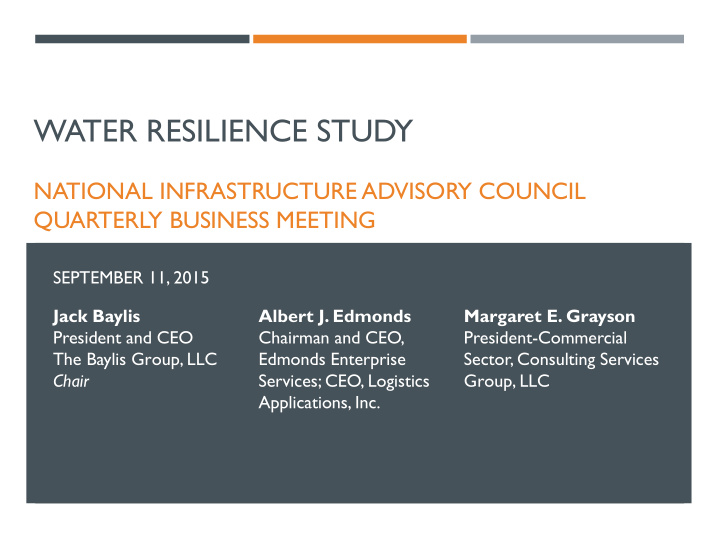



WATER RESILIENCE STUDY NATIONAL INFRASTRUCTURE ADVISORY COUNCIL QUARTERLY BUSINESS MEETING SEPTEMBER 11, 2015 Jack Baylis Albert J. Edmonds Margaret E. Grayson President and CEO Chairman and CEO, President-Commercial The Baylis Group, LLC Edmonds Enterprise Sector, Consulting Services Chair Services; CEO, Logistics Group, LLC Applications, Inc.
AGENDA Background Study Overview Proposed Approach Preliminary Schedule Questions 2
BACKGROUND 3
FORMATIVE NIAC STUDIES 4 NIAC studies have addressed critical infrastructure resilience: Critical Infrastructure Resilience (2009) A Framework for Establishing CI Resilience Goals (Electricity & Nuclear) (2010) Strengthening Regional Resilience (2013) Transportation Sector Resilience (2015) Water sector is a lifeline sector that provides indispensable services to nearly all other infrastructures and is critical to the recovery of other essential services following a major disruptive event. NIAC: The resilience of the lifeline sectors should be examined to identify potential gaps and seams and opportunities to address them. 4
WATER SECTOR STRUCTURE Water Sources Water Supply Wastewater Stormwater 5
WATER SECTOR INTERDEPENDENCIES Source: Water Sector-Specific Plan: Annex to the National 6 Infrastructure Protection Plan, 2010
REGIONAL WATER SECTOR ISSUES Source: NOAA, 2015 Source: NOAA, 2015 7
STUDY OVERVIEW 8
WORKING GROUP MEMBERS Jack Baylis , President and CEO, The Baylis Group, LLC (Chair) Albert J. Edmonds , Chairman and CEO , Edmonds Enterprise Services; CEO , Logistics Applications, Inc. Margaret Grayson , President-Commercial Sector , Consulting Services Group, LLC 9
STUDY CHARGE Apply the NIAC-recommended framework for establishing resilience goals (developed in the 2010 study) to the Water Sector in order to: Assess security and resilience in the water sector Uncover key water resilience issues Identify potential opportunities to address them. 10
FRAMEWORK FOR ESTABLISHING RESILIENCE GOALS Establish a baseline of current Assess sector resilience using a Clarify sector roles and practices high-impact event (beyond responsibilities, and design limits) infrastructure factors that affect Describe and organize practices resources using the NIAC Resilience Identify gaps and seams in Construct response Modify sector resilience goals based on lessons learned Set prospective sector goals implied by practices 11
PROPOSED APPROACH 12
FRAMING QUESTIONS 1. What current strategies and practices promote resilience in the sector? What differences or common areas of understanding of resilience and plan coordination exist across regions and subsectors? 2. What are the implicit resilience goals that are aligned with common practices for each region or sub-sector, and across the sector ? 3. What considerations and cascading effects result from interdependencies among sub-sectors and other infrastructure sectors, including cyber systems and their disruptions, within a region and across the nation? 13
FRAMING QUESTIONS 4. What potential gaps and seams exist that create obstacles for the sector and subsectors to achieve their resilience goals? 5. What unique factors within the sector influence risk mitigation ? What are the practical realities of risk priorities and risk mitigation, such as those related to investments and operations? 6. What roles and responsibilities should private sector and government at all levels play, operationally and at the senior executive level? 7. What new policies and strategies may be needed to improve resilience for the sector? What steps can the government take to implement them? 14
INFORMATION AND DATA SOURCES The NIAC Working Group will task a non-member Study Group to conduct research, interview subject matter experts, and assess sector resilience using a high-impact event. The Study Group will leverage the following: Interviews with infrastructure owners and operators, national leaders, State and local government representatives, and Federal agencies Research and analyze reports, studies, videos, news articles, testimonies, and policy directives Public sector briefings provided to the NIAC at-large Council member experience and expertise 15
PRELIMINARY SCHEDULE 16
STUDY TIMELINE Sep Oct Nov Dec Jan Feb Mar Apr May June Sep 11 Dec 4 Mar TBD June 3 NIAC QBMs Report Drafting Delivery to DFO Initial Briefs Conduct Interviews & Analysis & Initial Findings & & Council Research Integration Recs Working Group Deliverables Draft Findings & Draft Final NIAC Review/ Report Final Report Recommendations 17
NEXT STEPS Refine study approach and schedule for execution Identify additional critical resources for interviews and programmatic briefings, and develop additional study questions and taskings for study group Conduct interviews and briefings to collect data 18
QUESTIONS? 19
Recommend
More recommend